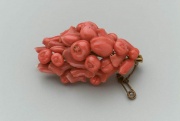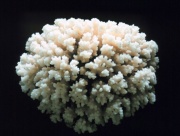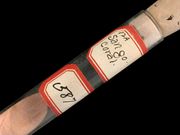Difference between revisions of "Coral"
m (Text replace - "== Authority ==" to "== Sources Checked for Data in Record ==") |
|||
| (9 intermediate revisions by the same user not shown) | |||
| Line 1: | Line 1: | ||
| − | [[File:43.2121-SC15838.jpg|thumb| | + | [[File:43.2121-SC15838.jpg|thumb|Brooch with coral pieces<br>MFA# 43.2121]] |
== Description == | == Description == | ||
| − | + | [[File:Coral.skeleton.NOAA.jpg|thumb|Skelton of coral colony]] | |
| − | 1) | + | 1) The [[calcium carbonate]] structure composed of the residual skeletons from colonies of soft-bodied marine animals of the class Anthozoa (phylum Cnidaria). Coral deposits accumulate at an average rate of about 0.5 to 2.8 cm per year to form reefs or islands in warm seas (13-15 C). Coral species are separated into hard (with skeletons) and soft (without skeletons). The hard, or calcareous group, includes: stony corals (star coral), black corals, thorny corals, horny corals (gorgonians), and blue corals. They can range in color from white, cream, red, blue, and black. Red, or precious, coral is considered the most valuable. It is obtained from the Mediterranean Sea and off the coast of Japan. Black coral can be bleached to give a 'golden' appearance. Hard corals have been used since antiquity to make jewelry, ornaments, beads, and decorative objects. The soft group of corals are bendable and only contain colonies of polyps. |
| − | + | [[File:Florida.Corals.Diag.NOAA.jpg|thumb|Florida corals]] | |
2) A pale orangy pink color. | 2) A pale orangy pink color. | ||
| − | + | [[File:587 san go coral.jpg|thumb|Coral color pigment]] | |
| − | [[File: | ||
| − | |||
== Synonyms and Related Terms == | == Synonyms and Related Terms == | ||
calcium carbonate; coral (Esp., Port.); Koralle (Deut.); corail (Fr.); corallo (It.); sango matsu (Jap.); koraal (Ned.) | calcium carbonate; coral (Esp., Port.); Koralle (Deut.); corail (Fr.); corallo (It.); sango matsu (Jap.); koraal (Ned.) | ||
| + | |||
| + | ==Physical and Chemical Properties== | ||
| + | For calcareous corals: | ||
| + | * Semitranslucent to opaque | ||
| + | * Luster = waxy to vitreous | ||
| + | * Fracture = conchoidal to splintery to uneven (depending on species) | ||
| + | * Fluorescence = inert to orange under LW and SW | ||
{| class="wikitable" | {| class="wikitable" | ||
| Line 18: | Line 23: | ||
|- | |- | ||
! scope="row"| Density | ! scope="row"| Density | ||
| − | | 2.60-2.70 | + | | 2.60-2.70 g/ml |
| + | |- | ||
| + | ! scope="row"| Refractive index | ||
| + | | 1.486 - 1.658 | ||
| + | |- | ||
| + | ! scope="row"| Birefringence | ||
| + | | 0.172 | ||
|} | |} | ||
| − | == | + | == Resources and Citations == |
| − | + | * Gem Identification Lab Manual, Gemological Institute of America, 2016. | |
| − | |||
| − | |||
| − | |||
| − | |||
| − | |||
| − | |||
| − | |||
| − | |||
| − | |||
* ''The American Heritage Dictionary'' or ''Encarta'', via Microsoft Bookshelf 98, Microsoft Corp., 1998 | * ''The American Heritage Dictionary'' or ''Encarta'', via Microsoft Bookshelf 98, Microsoft Corp., 1998 | ||
| − | + | * ''Encyclopedia Britannica'', http://www.britannica.com Comment: Coral. Retrieved May 26, 2003. | |
| − | * ''Encyclopedia Britannica'', http://www.britannica.com Comment: Coral. Retrieved May 26, 2003 | ||
| − | |||
* R. J. Gettens, G.L. Stout, ''Painting Materials, A Short Encyclopaedia'', Dover Publications, New York, 1966 | * R. J. Gettens, G.L. Stout, ''Painting Materials, A Short Encyclopaedia'', Dover Publications, New York, 1966 | ||
| − | |||
* G.S.Brady, ''Materials Handbook'', McGraw-Hill Book Co., New York, 1971 Comment: p. 235 | * G.S.Brady, ''Materials Handbook'', McGraw-Hill Book Co., New York, 1971 Comment: p. 235 | ||
| − | |||
* ''Dictionary of Building Preservation'', Ward Bucher, ed., John Wiley & Sons, Inc., New York City, 1996 | * ''Dictionary of Building Preservation'', Ward Bucher, ed., John Wiley & Sons, Inc., New York City, 1996 | ||
| − | |||
* Tom Rowland, Noel Riley, ''A-Z Guide to Cleaning, Conserving and Repairing Antiques'', Constable and Co., Ltd., London, 1981 | * Tom Rowland, Noel Riley, ''A-Z Guide to Cleaning, Conserving and Repairing Antiques'', Constable and Co., Ltd., London, 1981 | ||
| − | |||
* Oppi Untracht, ''Jewelry Concepts and Technology'', Doubleday & Co., Inc., New York City, 1985 | * Oppi Untracht, ''Jewelry Concepts and Technology'', Doubleday & Co., Inc., New York City, 1985 | ||
| − | |||
* Jack Odgen, ''Jewellery of the Ancient World'', Rizzoli International Publications Inc., New York City, 1982 | * Jack Odgen, ''Jewellery of the Ancient World'', Rizzoli International Publications Inc., New York City, 1982 | ||
| − | |||
* Art and Architecture Thesaurus Online, http://www.getty.edu/research/tools/vocabulary/aat/, J. Paul Getty Trust, Los Angeles, 2000 | * Art and Architecture Thesaurus Online, http://www.getty.edu/research/tools/vocabulary/aat/, J. Paul Getty Trust, Los Angeles, 2000 | ||
Latest revision as of 14:09, 28 December 2022
Description
1) The Calcium carbonate structure composed of the residual skeletons from colonies of soft-bodied marine animals of the class Anthozoa (phylum Cnidaria). Coral deposits accumulate at an average rate of about 0.5 to 2.8 cm per year to form reefs or islands in warm seas (13-15 C). Coral species are separated into hard (with skeletons) and soft (without skeletons). The hard, or calcareous group, includes: stony corals (star coral), black corals, thorny corals, horny corals (gorgonians), and blue corals. They can range in color from white, cream, red, blue, and black. Red, or precious, coral is considered the most valuable. It is obtained from the Mediterranean Sea and off the coast of Japan. Black coral can be bleached to give a 'golden' appearance. Hard corals have been used since antiquity to make jewelry, ornaments, beads, and decorative objects. The soft group of corals are bendable and only contain colonies of polyps.
2) A pale orangy pink color.
Synonyms and Related Terms
calcium carbonate; coral (Esp., Port.); Koralle (Deut.); corail (Fr.); corallo (It.); sango matsu (Jap.); koraal (Ned.)
Physical and Chemical Properties
For calcareous corals:
- Semitranslucent to opaque
- Luster = waxy to vitreous
- Fracture = conchoidal to splintery to uneven (depending on species)
- Fluorescence = inert to orange under LW and SW
| Mohs Hardness | 3.5 |
|---|---|
| Density | 2.60-2.70 g/ml |
| Refractive index | 1.486 - 1.658 |
| Birefringence | 0.172 |
Resources and Citations
- Gem Identification Lab Manual, Gemological Institute of America, 2016.
- The American Heritage Dictionary or Encarta, via Microsoft Bookshelf 98, Microsoft Corp., 1998
- Encyclopedia Britannica, http://www.britannica.com Comment: Coral. Retrieved May 26, 2003.
- R. J. Gettens, G.L. Stout, Painting Materials, A Short Encyclopaedia, Dover Publications, New York, 1966
- G.S.Brady, Materials Handbook, McGraw-Hill Book Co., New York, 1971 Comment: p. 235
- Dictionary of Building Preservation, Ward Bucher, ed., John Wiley & Sons, Inc., New York City, 1996
- Tom Rowland, Noel Riley, A-Z Guide to Cleaning, Conserving and Repairing Antiques, Constable and Co., Ltd., London, 1981
- Oppi Untracht, Jewelry Concepts and Technology, Doubleday & Co., Inc., New York City, 1985
- Jack Odgen, Jewellery of the Ancient World, Rizzoli International Publications Inc., New York City, 1982
- Art and Architecture Thesaurus Online, http://www.getty.edu/research/tools/vocabulary/aat/, J. Paul Getty Trust, Los Angeles, 2000



